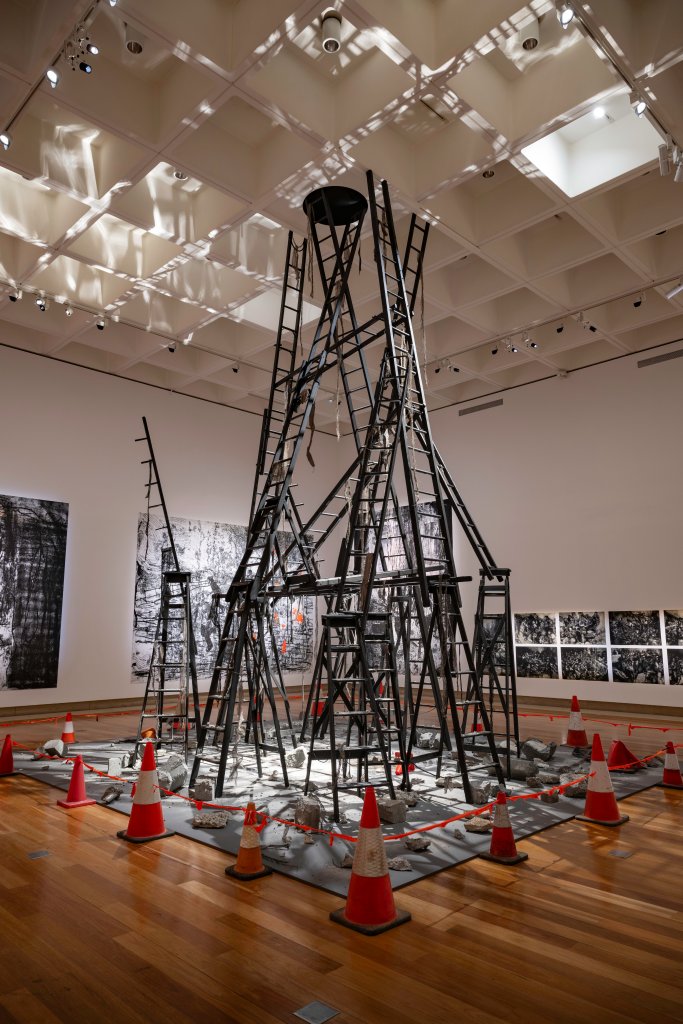Don’t turn away … the art of war and conflict
Queensland artist Pat Hoffie grapples with the futility of war and the power of art in her latest exhibition, now on at QAG.

To compare one artist to another is often unfair, but looking at Pat Hoffie’s powerful prints one cannot help but think of Spanish artist Francisco Goya whose The Disasters of War, a series of 82 prints created between 1810 and 1820, is a powerful indictment of war and conflict and the effect it has on human society.
Pat Hoffie’s exhibition, I have loved/I love/I will love, now showing at Queensland Art Gallery (a free exhibition) makes one think of Goya. I’m not suggesting it is derivative but it is, rather, in a grand tradition.
This is Hoffie’s first extensive body of work in printmaking as an immersive installation. And immersive it is … powerful, disturbing and impressive all at once. There is a certain wow factor to some of the works, considering their scale and the whole effect is quite moving.
Although, as Hoffie wryly remarked at the opening of the exhibition by State Arts Minister John-Paul Langbroek on the weekend, they are not the sort of works that “would be hung in someone’s loungeroom to match the décor”. Depending on the décor, of course. But her point is taken.
Enveloping the gallery space, her large-scale prints face towards an installation featuring a cluster of precarious ladders that speak to the chaos and fragility of our contemporary life.
As QAGOMA’s Grace Jeremy, assistant curator, Australian Art, points out in an essay about the exhibition: “Hoffie’s prints draw inspiration from a long line of artists who have used the medium to respond to the human consequences of war and conflict.”
You might like
“Over the challenging year of 2024 she transformed scenes she witnesses in the media and committed them to paper; through this she seeks to encourage the slow viewing and sincere contemplation of these often fleetingly glimpsed images. The conceptual foundation of Hoffie’s prints can be found in a long history of conflict represented in printmaking in the work of artists such as Jacques Callot, Francisco Goya and Kathe Kollwitz.”

Some of Goya’s prints from The Disasters of War series were on display in 2012 at Queensland Art Gallery in an exhibition of works from The Prado Museum in Madrid. Having seen them and, now, looking at Hoffie’s works, one can see a direct link. She is part of a historical continuum in this way, as Jeremy suggests.
“Hoffie falls within this history as another artist who uses print to grapple with representations of war and to foster compassion for those caught in its crossfires,” Jeremy writes. “Like Callot, Goya and Kollwitz, she focuses on the experiences of ordinary people involved in events of international significance – a consistent thread throughout her broader practice.”
In a limited-edition book accompanying the exhibition (each edition of 200 copies is signed and numbered), Hoffie writes about how world events affected and informed her art practice during time spent in the studio in 2024 – and became reflected in it.
“Long solitary hours spent working in the studio became steadily saturated by the deluge of accounts of overseas warfare that ran on endlessly that year,” Hoffie writes.
Subscribe for updates

She says she felt compelled to respond and as she grappled with the subject matter she also grappled with printmaking itself, a kind of alchemical process that any great artist will have a crack at some time in their career. But can making art about conflict and the human condition in extremis have any effect?
the works draw from the socially mediatised imagery Hoffie has described as interminably running on as ‘the background to my days’
“Art never stopped a war, one sober friend chastened me,” Hoffie writes. “He was right. All artists are aware of the bruised futility of art’s faith. But my friend has forgotten the rest of Bernstein’s quote: ‘that was never its function … Art cannot change events. But it can change people’.
“Throughout history, from amidst the rubble and ruin, other crises of heartlessness and hopelessness, art has maintained its tiny persistent drive to dig down, to reach out and upwards, yearning for, calling out to those who have refused to abandon hope and love.”
This exhibition presents the artist’s first extensive body of work in printmaking. Engaging with printmaking’s historical legacy in transmitting images of human conflict, the works draw from the socially mediatised imagery Hoffie has described as interminably running on as “the background to my days”. She transforms scenes she has witnessed through the media by using techniques that combine monoprint, drypoint, digital technologies and found materials.
Pat Hoffie is one of Queensland’s most important artists. She has had a long and illustrious career and yet she can still surprise us with the power and the passion of her work. This is an impressive and important exhibition that everyone should see.
Pat Hoffie – I have loved/I love/I will love continues at Queensland Art Gallery (free admission) until February 1.
qagoma.qld.gov.au/exhibition/pat-hoffie-i-have-loved-i-love-i-will-love
Free to share
This article may be shared online or in print under a Creative Commons licence

